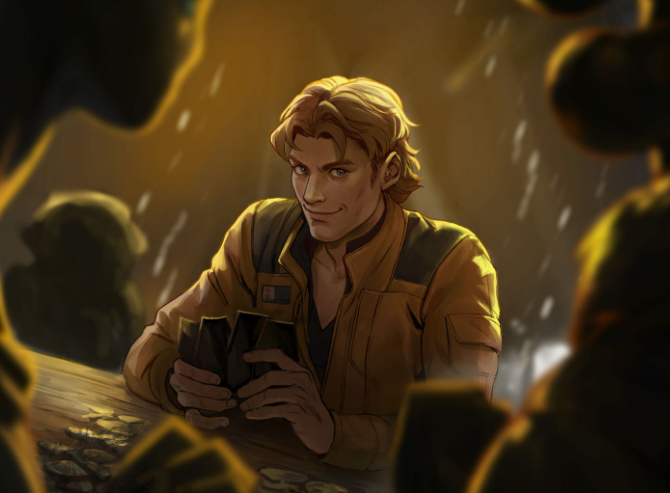
Trending Today

Welcome back to our series of articles on Fantasy Flight Games’s upcoming Star Wars Unlimited TCG! This is likely the last SWU article you’ll see here at The Fifth Trooper before the game is on store shelves — get hyped! (For those who may not have seen our previous articles on the game, you can check them out here!)
One exciting thing about SWU is that it will have options for Draft and Sealed formats, providing fun and accessible modes of play that do not require a full collection. Readers who might be less familiar with trading card games may not have heard of these formats, but they can provide great options for how to engage with a game — for some, draft might be their favorite format a game has to offer!
Star Wars Unlimited Draft and Sealed play works in a fairly straightforward manner — instead of building decks based on their preexisting collections, players will open packs as part of the event and use the cards from those packs to build decks that they will then play with! The two formats — sometimes referred to collectively as “Limited play” — have slightly different ways to approach this, though there are a few constants between the formats as well.
Star Wars Unlimited Draft and Sealed decks are both a minimum of thirty cards rather than the usual fifty. Further, players are allowed to choose any common base they want for their decks, even if they did not pull them in the packs that they opened. Additionally, the normal restriction on maximum three copies of a certain card is lifted — if you happen to be fortunate enough to get six Green Squadron A-Wings somehow, you can play all of them!
One other notable thing about Draft and Sealed is that Limited decks are generally going to be a lot worse than constructed ones! In general, Limited decks have weaker cards, fewer powerful rare cards, and worse/less consistent removal options than constructed decks do. This is part of what makes Limited an appealing challenge — it’s not just “choose the best cards from the cardpool”, but rather a system that encourages players to make the most of what a much more limited group of cards has to offer!
Lastly, Star Wars Unlimited draft and sealed play is where the game’s system allowing out of aspect cards is most likely to shine. If you draft a strong card that is out of aspect — at least if there’s only one “missing aspect icon” — it might actually be worth playing it in your deck and just paying the two extra resources!
In Draft, players take three fresh booster packs each, then take turns taking one card from each pack and passing the remaining cards around the table. This allows you some agency in what cards end up being part of your overall cardpool for building a deck, as well as creating interesting dynamics in terms of card evaluation and prioritization.
For Star Wars Unlimited, draft has two different phases — first, you have a brief leader draft, where you take the leader out of each of your packs, select one, pass the other two to your right (and get passed two leaders by the player on your left), select one of the two leaders you were just passed, pass the remaining leader to your right, and get passed a leader by the player on your left. These three leaders then become your leader options for this draft.
In the second phase, players look at the non-leader cards from each pack (other than common bases), select one, and pass the rest of the cards to the player on their left. This process then continues until the packs run out of cards, at which point you move to the next pack (passing to the right this time) and repeat; once the second packs run out of cards you move to the third pack and pass left again.
At the end of this, you’ll have a bunch of cards with which to build a deck — three leaders, a bunch of normal cards, and maybe even a rare base. You can then either add any common base of your choice to your deck, or play a rare base that you drafted. At that point you go ahead and build, though with a 30 card minimum instead of the standard 50 card minimum. In general, you should try to play the minimum deck size — this means you’ll likely have some unused cards left over, which is normal and fine!
When leader drafting, I strongly recommend trying to get both a Villainy and Heroism leader that you are comfortable playing with in your pool of available leaders. If you have three Villainy or three Heroism leaders, you will be much more constrained in terms of what decks you can potentially build; having at least one viable option for Villainy and one for Heroism will allow you to be open to many more possibilities. Similarly, try to avoid having duplicate leaders, as this will constrain your options.
One key concept in drafting across multiple games is reading and sending signals. While we haven’t seen the full rules and floor rules for Star Wars Unlimited yet, “table talk” that explicitly discusses (or even hints at) what you are drafting is generally banned in “serious” play, so players need to instead rely on signals — drafting decisions that indicate what one likely is (or isn’t!) drafting.
This can be important because you generally want to draft aspect combinations that people around you are not drafting. If you and your neighbors are all trying to grab the Command/Heroism cards, you’ll split the cardpool among yourselves and likely all end up with weaker decks. On the other hand, if you’re the only player at the table picking up a particular aspect combination, you’ll be able to choose from more options.
A classic example of a signal is receiving a pack with a very strong card that has gone undrafted. For instance, if I receive a pack that has a copy of a very powerful card like Luke Skywalker, Jedi Knight or Overwhelming Barrage, that is a strong indication that people in front of me are likely not drafting those aspects — if they were, a card that powerful would be hard to pass up! The later in a draft you receive a card like this, the stronger a signal it is, since it means more players have seen the card and passed it up.
Similarly, if I repeatedly receive packs that have very little to offer from a certain aspect combination, that is a strong signal that someone ahead of me is drafting that combination, and hence that it might be imprudent for me to go for the same thing.
Note that the importance of signals is much higher in early picks, because late in the draft players have already committed to many cards and are less able to swap. You might send the strongest signal in the world in pack three and have nobody respond — they’ve already committed to other builds!
Lastly, one other signal that Star Wars Unlimited offers and other games don’t is leader selection! If the player to your right has only Villainy leaders, that is a very strong signal that they will be passing you a bunch of Heroism cards, and you may wish to adapt accordingly! Similarly, players are more likely to draft “neutral aspects” that one of their leaders has to offer — be careful though, because someone could always use their base to provide a neutral aspect not featured on their leaders!
In general, when drafting it is often favorable to “stay open” early on in the draft, intentionally taking cards that can fit into a range of different decks. The flexibility of Star Wars Unlimited’s aspect system means that there are multiple different ways to stay open while drafting.
For instance, let’s say I have Jyn Erso, Resisting Oppression (a Cunning/Heroism leader) and Boba Fett, Collecting the Bounty (a Cunning/Villainy leader) in my pool. I can stay open to either of these options by drafting strong Cunning cards that are neither Heroic nor Villainous, thus allowing me to use them either way. Then, I can see whether I seem to be getting passed better cards for Heroism or Villainy and choose my aspect accordingly.
For a more advanced example of “staying open”, let’s say that instead of Jyn and Boba I have Jyn and Tarkin (a Command/Villainy leader). In this case, I can still stay open by drafting Cunning (or Command) cards and committing to either run them via my leader’s aspect (if going Jyn) or my base’s aspect (if going Tarkin). This is not quite as open as the earlier example but still offers some good flexibility.
By staying open, you give yourself more time to read signals and see what looks like a good option for you to run based on what is or isn’t being passed around the draft. However, if you try to stay open for too long, you will likely degrade your card quality by picking worse but “more open” cards over stronger but “more committed” cards.
Forcing is the opposite of staying open. When you force an aspect, you commit to a certain combination from very early on in the draft and prioritize taking cards of those colors. For example, I might have Sabine Wren, Galvanized Revolutionary as the only leader I’m excited to play in my pool, see the strong K-2SO, Cassian’s Counterpart as the rare in my first pack, and hence commit to drafting Aggression/Heroism cards from very early on in the draft.
One advantage of forcing is that it will (hopefully!) send a strong and early signal to other players that someone is drafting that combination. However, it is also relatively inflexible — while you have some wiggle room with a secondary aspect, you’ll be less able to adapt to signals, and committing to a certain set of aspects means likely taking weaker cards that are in “your colors” versus stronger cards from other aspects.
As a general rule of thumb, newer players are somewhat more likely to force, while more experienced players are somewhat more likely to try and remain open and read signals before committing.
Hatedrafting is a tactic where instead of drafting a card that you think will improve your deck, you draft a card that you do not expect to play in order to prevent opponents from drafting it. Hatedrafting is usually not a good tactic, since upgrading your own deck is likely going to be better for your chance of winning than slightly weakening someone else’s — you might not even end up playing against that player! However, if you have a pack that really lacks any major upgrade for your build, removing the best card someone else could play might be appropriate!
Value drafting (sometimes called “rare drafting”) is a tactic where instead of drafting a card that you think will improve your deck, you draft a card that you do not expect to play but want to have in your collection, either because you want the card or because it offers high value for trading or selling! For example, if you pull a hyperspace foil Boba Fett, Disintegrator — a card that will likely be valuable on the secondary market — you may wish to pick it even if your deck will not be able to run the card efficiently.
While value drafting is bad for your odds of winning an event compared to picking the most effective card, it might be positive expected value as a whole, depending on the prizes of the event and the value of the card in question. While some players dislike value drafting or see it as an ‘impure’ tactic, it can be a reasonable decision in at least some cases. After all, if you’re playing in a local “win a booster for each win!” event and you draft a card that is bad in your deck that you can potentially trade for multiple boosters’ worth of value, that’s probably an overall win!
Note that some stores/tournament organizers may run draft events that use “rare redraft” (a system where all the cards above a certain rarity are pooled at the end and then drafted for keeps, with the winner going first, the second-place player going second, etc.). I personally dislike “rare redraft” and consider it unfriendly to new players. If you are playing in a draft that has rare redraft, you should be sure not to value draft, as value drafting will degrade your deck quality and you might not even get to keep the cool card you drafted!
Compared to Draft, Sealed play offers a much simpler and easier Limited experience, and also one that is less reliant on having exact numbers of players (Draft is best with exactly eight players participating). To play Sealed, you simply open six packs and make a deck with what you find inside, then play against other players who did the same!
One simple tactic to use in Sealed is simply to count the number of good (or at least decent) cards you have for each aspect combination in order to see what your cardpool favors — keeping in mind that you will likely run some below average cards in order to hit the minimum deck size! For example, if I have six great Aggression/Villainy cards, four great Command/Villainy cards, a fair few decently strong Aggression and Command “neutrals”, and not a lot of great options elsewhere, that might well point me towards those aspects!
Another interesting thing that might not immediately be apparent is that Sealed decks are generally not just a lot weaker than constructed decks, but even a lot weaker than Draft ones! This might seem odd — wouldn’t having six packs worth of cards be better than three packs worth of cards? The difference is that in Draft, you have “three packs of cards” but curate your selection by picking cards that fit with your aspect combination, while in Sealed you have “six packs of cards” but many of those will be in aspects that you don’t run, making them significantly weaker choices!
Players participating in Spark of Rebellion prerelease events (which begin in just a bit more than two weeks!) will also have access to alt art versions of Luke Skywalker, Faithful Friend and Darth Vader, Dark Lord of the Sith, and can choose to use one of those as their leaders instead of one of the leaders they drew from their packs. Luke and Vader are both strong leaders and this might well be a valid option, so don’t count them out just because they’re “starter” characters!
Overall, Star Wars Unlimited Draft and Sealed play provides an interesting alternate way to play the game that doesn’t require having an established collection already. In fact, playing Draft and Sealed can help you build your collection while having fun doing it! I personally quite enjoy playing Sealed early in a set — it’s a great format for prereleases — seeing what the cardpool has to offer, and engaging in drafts later on as things get more understood.
Hopefully this overview will help you get a better sense of what these formats have to offer and what some of the strategies involved may look like. Until next time, this is TowerNumberNine signing off — best of luck at any upcoming prereleases you might attend and anything else Star Wars Unlimited Draft and Sealed may end up offering you!


Copyright © 2024 The Fifth Trooper. All Rights Reserved.